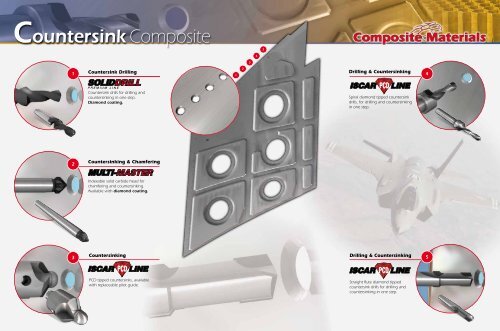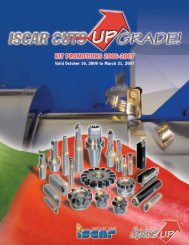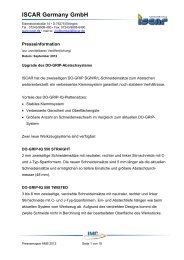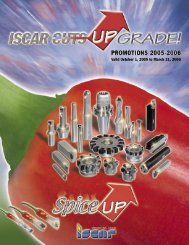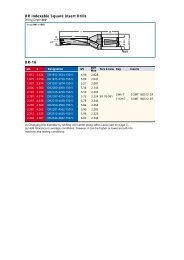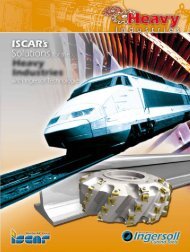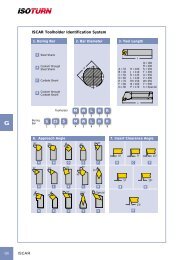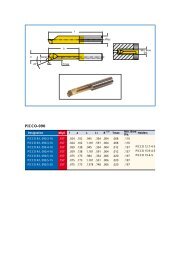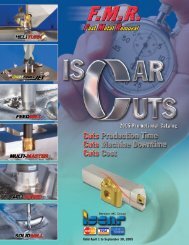Composite Materials Brochure - Iscar Ltd.
Composite Materials Brochure - Iscar Ltd.
Composite Materials Brochure - Iscar Ltd.
Create successful ePaper yourself
Turn your PDF publications into a flip-book with our unique Google optimized e-Paper software.
Metal Cutting LeadershipDeliveringProfitabilityI S C A R G u a r a n t e e s R e s u l t sThe increased popularity of composites in aerospaceapplications creates new challenges for shops that are usedto cutting metal. One of these substances, carbon fiberreinforcedplastic (CFRP), can be especially difficult to drillbecause instead of executing a clean cut, tools often ‘push’through the material.At ISCAR we realize that these materials are extremelyabrasive and difficult to machine, as a result of the differentphysical properties of the materials used in the layers thatmake these composites hard, tough and strong. Due to theharsh cutting environment, tool life can be very short whenmachining CFRP composites. As the exact formula of whatthese composites are made from is not known, it can bedifficult to design appropriate tools.Much of ISCAR’s R&D resources are spent to solve theproblem of machining these complex materials.The machining of materials which are used for advancedtypes of aircraft demands new processes, as these difficultmaterials are lightweight, yet very strong.The tooling that shops commonly use for machining CFRPfeatures long-lasting diamond PCD insert drills, vein PCDdrills or brazed mandrel tools. When machining compositessuch as CFRP – there is no chip to speak of. Instead, thematerial removal mechanism might be better described asshattering.The impact of the cutting edge fractures the hard carbonfibers, instead of shearing material away.This process causes the cutting edge considerable abrasionthat can lead to rapid wear. In composite machining, aswell as any cutting tool application, tool geometry drivescutting performance. However, in composites, tool materialalso becomes a driver of performance. Unless the edgematerial can withstand the abrasion well enough to hold itsgeometry and stay sharp, the tool can wear so rapidly thatthe geometry can change rapidly as well.In order to successfully machine CFRP, ISCAR has developedhard, sharp solid-carbide tools which are coated with hard,long-lasting diamond.The diamond coating used is commonly a polycrystallinediamond (PCD) coating. However, a diamond coatingapplied by the chemical-vapor-deposition (CVD) processis the only coating that utilizes 100% real diamond crystals.A large advantage of CVD diamond coatings is that theyreduce heat and friction created by the highly abrasivecomposite. Though the machining operations required forcomposite parts may be simple (sometimes only drilling andtrimming), the fixtures designed to support these parts canbe small feats of engineering themselves.Thus, the fixture for machining a composite part can be aconsiderable engineering investment. Clean cutting withoutfraying, delamination or otherwise separation of the layers,requires the part to be firmly secured against vibration.ISCAR’s engineers workclosely with advancedaerospace industries inorder to understand theirnew demands for efficientmachining of lightweightcomposites.Quality StandardISCAR has been certified by the prestigious StandardsInstitution, as being in full compliance with qualitystandards AS 9100, ISO 9001:2000, OHSAS 18001and ISO 14001. Incoming batches of carbidepowders are carefully analyzed to ensure that theraw materials do not deviate from set standards.In addition, completed products are inspectedbefore shipping, to ensure delivery of the finestquality goods. Quality control facilities include themetallurgical laboratory, raw metal testing, an onlinetesting procedure and a machining center for toolperformance testing and final product inspection.Only the finest products are packaged for entry intoISCAR’s inventory.


